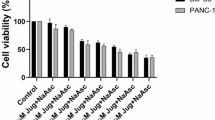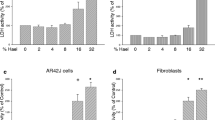Abstract
Pancreatic cancer is an aggressive tumor with short median survival and high mortality rate. Alternative therapeutic modalities are currently being evaluated for pancreatic cancer. Here we studied the effects of ascorbyl stearate (Asc-S), a nontoxic, lipophilic derivative of ascorbic acid, on pancreatic cancer. Treatment of human pancreatic carcinoma cells with Asc-S (50–200 μM) resulted in a dose-dependent inhibition of their proliferation. Asc-S slowed down the cell cycle, accumulating, PANC-1 cells in late G2-M phase. Furthermore, Asc-S treatment (150 μM) markedly inhibited growth in soft agar and facilitated apoptosis of PANC-1 cells but not of Capan-2 cells. These effects were accompanied by a significant reduction in insulin-like growth factor 1 receptor (IGF1-R) expression, as compared to untreated controls. Interestingly, Capan-2 cells, the least responsive to Asc-S treatment, did not overexpress the IGF1-R. The results demonstrate the efficacy of Asc-S in inhibing growth of pancreatic cancer cells and warrant additional studies to explore the potential utility of this compound as an alternative and/or adjuvant therapeutic modality for pancreatic cancer.
Similar content being viewed by others
REFERENCES
Globocan 2000: Cancer Incidence, Mortality and PrevalenceWorldwide, Version 1.0., IARC Cancer Base No. 5, Lyon, IARC Press, 2001
Warshaw AL, Fernandez-del Castillo C: Pancreatic carcinoma. N Engl J Med 326:455, 1992
Buncher CR: Epidemiology of pancreatic cancer. In Tumors of the Pancreas. (AR Moosa (ed)). Baltimore, Williams & Wilkins, 1980, pp. 415-427
Gudjonsson B, Livstone EM, Spiro HM: Cancer of pancreas. Diagnostic accuracy and survival statistics. Cancer 42:2494, 1978
Brooks JR, Culebras JM: Cancer of the pancreas, palliative operation, Whipple procedure, or total pancreatectomy. Am J Surg 131:516, 1976
Jemal A, Thomas, A, Murray T, Thun, M: Cancer statistics, 2002. CA Cancer J Clin 52:23-47, 2002
Pauling L: Effect of ascorbic acid on incidence of spontaneous mammary tumours and UV light induced skin tumors in mice. Am J Clin Nutr 54:1252S, 1991
Bishun N, Basu TK, Metcalfe S, Williams DC: The effect of ascorbic acid (vitamin C) on two tumor cell lines in culture. Oncology 35:160, 1978
Bishun NP, Williams DC, Basu TK, Metcalfe S: The effect of ascorbic acid on RNA and protein synthesis on two cultured cell lines in vitro. Cytobios 25:29, 1979
Naidu AK, Wiranowska M, Kori SH, Roetzheim KC, Kulkarni AP: Inhibition of cell proliferation and glutathione S-transferase by ascorbyl esters and interferon in mouse glioma. J Neuro-Oncol 16:1, 1993
Naidu AK, Wiranowska M, Kori SH, Prockop LD, Kulkarni AP: Inhibition of human glioma cell proliferation and glutathione S-transferase by ascorbyl esters and interferon. Anticancer Res 13:1469, 1993
Smart RC, Crawford CL: Effect of ascorbic acid and its synthetic lipophilic derivative ascorbyl palmitate on phorbol ester-induced skin-tumor promotion in mice. Am J Clin Nutr. 54:1266S, 1991
Tsao CS: Inhibiting effect of ascorbic acid on growth of human mammary tumor xenografts. AmJ Clin Nutr 54:1274S-1280S, 1991
Snedecor GW, Cochram WG: Statistical Methods. The Iowa State University Press, Ames, Iowa, 1967
Banks WA, Kastin AJ: Peptides and the blood-brain barrier: lipophilicity as a predictor of permeability. Brain Res Bull. 15:287, 1985
Nihro Y, Miyataka H, Sudo T, Matsumoto H, Satoh T: 3-O-alkylascorbic acids as free-radical quenchers: synthesis and inhibitory effect on lipid peroxidation. J Med Chem 34:2152, 1991
Nihro Y, Sogawa S, Izumi A, Sasamori A, Sudo T, Miki T, Matsumoto H, Satoh T: 3-O-alkylascorbic acids as free radical quenchers. 3. Protective effect on coronary occlusion-reperfusion induced arrhythmias in anesthetized rats. J Med Chem 35:1618, 1992
Sell C, Dumenil G, Devaud C, Miura M, Coppola D, DeAngelis T, Efstratiadis A, Baserga R: Effect of a null mutation of the type 1 IGF receptor gene on growth and transformation of mouse embryo fibroblast. Mol Cell Biol 14:3604-3612, 1994
Park CH, Mammo A, Savin MA, Hoogstraten B: Growth suppression of human leukemia cells in vivo by L-ascorbic acid. Cancer Res 40:1062-1065, 1980
Liehr JG: Vitamin C reduces the incidence and severity of renal tumors induced by estradiol or diethylstilbestrol. Am J Clin Nutr 54:1256S, 1991
Ibric LL, Peterson AR, Sevanian A: Mechanisms of ascorbic acidinduced inhibition of chemical transformation in C3H/10T1/2 cells. Am J Clin Nutr 54:1236S, 1991
Aidoo A, Lyn-Cook LE, Lensing S, WamerW: Ascorbic acid (vitamin C) modulates the mutagenic effects produced by an alkylating agent in vivo. Environ Mol Mutagen 24:220, 1994
Werner B, Hrynyschyn K, Schafer H: Vitamin C in a long-term trial is without effect on experimental carcinogenesis. Langenbecks Arch Chir 363(3):185-193, 1985
Bal E, deLustig ES: Prostate carcinogenesis in vitro. Unresponsiveness to ascorbic acid. Medicina 36(1):23-28, 1976
Liu XY, Guo FL, Wu LM, Liu YC, Liu ZL: Remarkable enhancement of antioxidant activity of vitamin C in an artificial bilayer by making it lipo-soluble. Chem Phys Lipids 83(1):39-43, 1996
Naidu KA, Tang JL, Naidu KA, Prockop LD, Nicosia SV, Coppola D: Antiproliferative and apoptotic effect of ascorbyl stearate in human glioblastoma multiforme cell: modulation of insulin-like growth factor-I receptor (IGF-IR) expression. J. Neuro-Oncol 54:15-22, 2001
Bijur GN, Briggs B, Hitchcock CL, Williams MV: Ascorbic aciddehydroascorbate induces cell cycle arrest at G2M DNA damage checkpoint during oxidative stress. Environ Mol Mutagen 3(2): 144-52, 1999
Bergmann U, Funatomi H, Yokoyama M, Beger HG, Korc M: Insulin-like growth factor I overexpression in human pancreatic cancer: evidence for autocrine and paracrine roles. Cancer Res 55:2007, 1995
Freeman JW, Mattingly CA, Strodel WE: Increased tumorigenicity in the human pancreatic cell line MIAPaCa-2 is associated with an aberrant regulation of the IGF-1 autocrine loop and lack of the expression of the TGF-beta type RII receptor. J Cell Physiol 165:155, 1995
Flossmann-Kast BBM, Jehle PM, Hoeflich A, Adler G, Lutz MP: Src stimulates insulin-like growth factor 1(IGF1)-dependent cell proliferation by increasing IGF-1 receptor number in human pancreatic carcinoma cells. Cancer Res 58:3551, 1998
Baserga R: Controlling IGF-receptor function: a possible strategy for tumor therapy. Trends Biotechnol 14:150, 1996
ResnicoffM, Ambrose D, Coppola D, Rubin R: Insulin-like growth factor-1 and its receptor mediate the autocrine proliferation of human ovarian carcinoma cell lines. Lab Invest 69:756, 1993
Resnicoff M, Coppola D, Sell C, Rubini R, Ferrone S, Baserga, R: Growth inhibition of human melanoma cells in nude mice by antisense strategies to the type 1 insulin-like growth factor receptor. Cancer Res 54:4848-4850, 1994
Ambrose D, Resnicoff M,. Coppol D, Sell C, Miura C, Jameson S, Baserga R, Rubin R: Growth regulation of human glioblastoma T98G cells by insulin-like growth factor-1 and its receptor. J Cell Physiol 159:92-100, 1994
Wu Y, Tewari M, Cui S, Rubin R: Activation of the insulin-like growth factor-1 receptor inhibits tumor necrosis factor-induced cell death. J Cell Physiol 168:499, 1996
Resnicoff M, Abraham D, Yutanawiboonchai W, Rotman HL, Kajstura, J, Rubin R, Zoltick P, Baserga R: The insulin-like growth factor 1 receptor protects tumor cells from apoptosis in vivo. Cancer Res 55:2463, 1995
Kaleko M, Rutter WJ, Miller AD: Over expression of the human insulin like growth factor 1 receptor promotes liganddependent neoplastic transformation. Mol Cell Biol 10:464, 1990
O'Connor R, Kauffmann-Zeh A, Liu Y, Lehar S, Evan GI, Baserga R, BlattlerWA: Identification of domains of the insulin-like growth factor 1 receptor that are required for protection from apoptosis. Mol Cell Biol 17:427-435, 1997
Resnicoff M, Huang Z, Herbert D, Abraham D, Baserga R: A novel class of peptides that induce apoptosis and abrogate tumorigenicity in vivo. Biochem Biophys Res Commun 240:208-212, 1997
Medina MA, De Vegas RG, Schweigerer B: Ascorbic acid ia cytotoxic for pedioatric tumor cells cultured in vitro. Biochem Mol Biol Int 34:871-874, 1994
Sakagami H, Satoh K, Ohata H, Takahashi H, Iida M, Kuribayashi N, Sakagami T, Momose K, Takeda M: Relationship between ascorbyl radical intensity and apoptosis-inducing activity. Anticancer Res 16:2635-2644, 1996
Dawson G, Kilkus J, Schieven GL: Selective phosphotyrosine phosphatase inhibition and increased ceramide formation is associated with B-cell death by apoptosis. FEBS Lett 478(3):233-236, 2000
Author information
Authors and Affiliations
Rights and permissions
About this article
Cite this article
Naidu, K.A., Karl, R.C., Naidu, K.A. et al. Antiproliferative and Proapoptotic Effect of Ascorbyl Stearate in Human Pancreatic Cancer Cells: Association with Decreased Expression of Insulin-Like Growth Factor 1 Receptor. Dig Dis Sci 48, 230–237 (2003). https://doi.org/10.1023/A:1021779624971
Issue Date:
DOI: https://doi.org/10.1023/A:1021779624971




